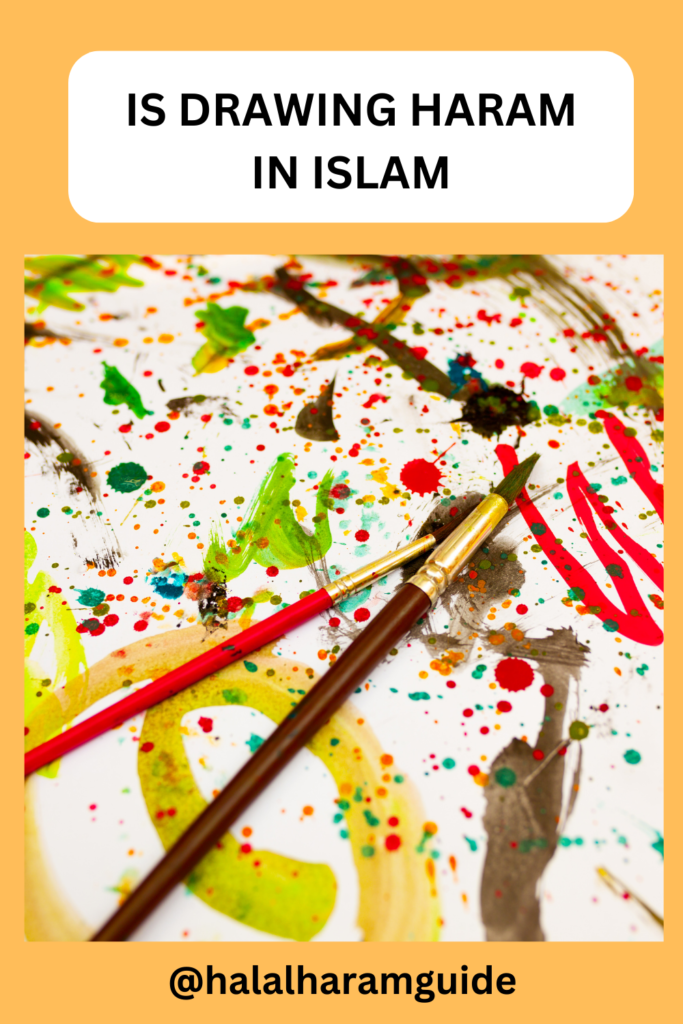Welcome to our blog post where we delve into a topic of significance: “Is Drawing Haram in Islam?” In this discussion, we aim to provide you with a clear and accessible exploration of the Islamic perspective on drawing and the nuanced considerations surrounding this creative practice within the context of Islamic teachings.
Whether you’re an artist seeking guidance or simply curious about the intersection of art and religion, we’re here to shed light on this subject with simplicity and accuracy.
Is Drawing Haram In Islam?
Drawing in Islam is a subject that generates varying opinions among scholars. While some argue that it can be permissible, others maintain that certain forms of drawing, particularly those that depict living beings, can be haram (forbidden).
The primary concern is the potential for drawings to lead to idolatry or promote a disrespectful portrayal of God’s creation.
Therefore, the permissibility of drawing in Islam often depends on the intention behind the artwork and the specific content. Muslims seeking guidance on this matter may consult with knowledgeable religious authorities for a more precise understanding within their religious context.
Which Drawings Are Haram in Islam?
In Islam, drawings that are generally considered haram (forbidden) are those that depict living beings with complete features, particularly human or animal forms.
The permissibility of specific drawings can vary among scholars and communities, so it’s advisable for Muslims to seek guidance from knowledgeable religious authorities regarding the acceptability of their artwork.
Why Is Drawing Haram In Islam?
The prohibition of drawing living beings, particularly humans and animals, in Islam is rooted in concerns about the potential for these images to lead to idolatry, arrogance, or disrespect for God’s creation.
Islam places a strong emphasis on the oneness and uniqueness of God, and there is a fear that creating images of living beings could divert one’s attention from the worship of God alone.
Additionally, there is a concern that such images might be used for wrongful or idolatrous purposes.
Hadith On Drawing In Islam In Quran?
The Quran does not explicitly mention the prohibition of drawing or creating images. However, Islamic scholars have derived some guidance on this matter from Hadith (sayings and actions of the Prophet Muhammad, peace be upon him).
Hadiths caution against creating images of living beings and emphasise the importance of avoiding idolatry and arrogance.
While the Quran provides general principles, Hadiths provide additional context and guidance, which have contributed to the understanding of the permissibility of drawing in Islam.
Is Drawing Animate Beings Haram In Islam?
Drawing animated beings, such as humans and animals with complete features, is generally considered a matter of caution in Islam, with varying opinions among scholars.
Some scholars consider it haram (forbidden) due to concerns about idolatry and disrespect for God’s creation, while others may allow it under specific conditions, such as when the intention is not to compete with God’s creation or engage in idolatrous practices.
The permissibility of drawing animated beings in Islam can vary depending on the interpretation and the specific content of the artwork.
Conclusion
In conclusion, the permissibility of drawing in Islam, particularly when it comes to animate beings, remains a complex and debated topic.
While some scholars hold that it is haram due to concerns about idolatry and arrogance, others provide more nuanced interpretations that consider intentions and specific contexts.
Ultimately, Muslims seeking guidance on drawing should consult with knowledgeable religious authorities who can provide context-specific rulings and ensure that their creative practices align with their religious beliefs and values.
Frequently Asked Questions
1. Is Drawing Haram In Islam?
Drawing in Islam is a subject that generates varying opinions among scholars. While some argue that it can be permissible, others maintain that certain forms of drawing, particularly those that depict living beings, can be haram (forbidden).
The primary concern is the potential for drawings to lead to idolatry or promote a disrespectful portrayal of God’s creation.
Therefore, the permissibility of drawing in Islam often depends on the intention behind the artwork and the specific content.
2. Is Drawing Pictures Haram In Islam?
In Islam, drawings that are generally considered haram (forbidden) are those that depict living beings with complete features, particularly human or animal forms.
This prohibition stems from concerns about the potential for such images to lead to idolatry or disrespect for God’s creation.
However, Islamic art often includes permissible forms of representation such as calligraphy, geometric patterns, and non-representational designs.
3. Is Making Cartoons Haram In Islam?
The permissibility of making cartoons in Islam, like other forms of art, depends on several factors, including the content, intention, and potential impact.
However, if cartoons contain disrespectful or offensive content, promote harmful values, or are used to mock religious figures or beliefs, they may be considered haram.
It is essential for Muslims involved in creating cartoons to be mindful of the content and intentions behind their work and to ensure that it aligns with Islamic principles of respect and decency.
4. Is Drawing Haram In Shia Islam?
In Shia Islam, the permissibility of drawing, particularly drawings of animate beings, is generally subject to similar principles and considerations as in Sunni Islam. Shia scholars often evaluate the act of drawing based on the content, intention, and potential consequences of the artwork.
Just as in Sunni Islam, some Shia scholars may consider drawings that depict living beings with complete features as problematic due to concerns about idolatry, arrogance, or disrespect for God’s creation. However, interpretations can vary among Shia scholars, and some may provide more lenient views depending on the specific context and intention behind the drawings.
As with any religious matter, individuals seeking guidance on drawing in Shia Islam should consult with knowledgeable Shia scholars or religious authorities who can provide context-specific rulings and guidance in accordance with their specific beliefs and practices.
5. What Type Of Art Is Haram In Islam?
In Islam, art is generally considered haram (forbidden) if it contains elements that go against the principles and values of the faith.
Furthermore, any art that promotes sinful behaviour, such as alcohol consumption, gambling, or theft, is discouraged.
Islamic art has a rich tradition of calligraphy, geometric patterns, and non-representational designs that align with Islamic values, and these forms of art are typically considered permissible and even encouraged.
6. Is Drawing The Prophet Haram?
Yes, in Sunni Islam, drawing or depicting the Prophet Muhammad (peace be upon him) is generally considered haram (forbidden).
This prohibition is rooted in a deep respect for the Prophet and a desire to prevent any form of idolatry, veneration, or disrespect.
Islamic tradition discourages any visual representations or drawings of the Prophet to avoid the risk of people worshipping such images or engaging in disrespectful practices.
It’s crucial to respect and understand the religious beliefs and practices of Muslims regarding this sensitive issue.
- “Is Lobster Halal? Understanding Its Permissibility”
- “Is Drawing Haram in Islam? Understanding the Perspective”
- “Is Fermented Kimchi Halal? Exploring Kimchi’s Halal Status”
- “Is Collagen Halal? Unveiling the Halal Status of Collagen”
- “Is Wine Vinegar Halal? Unveiling Its Permissibility”


